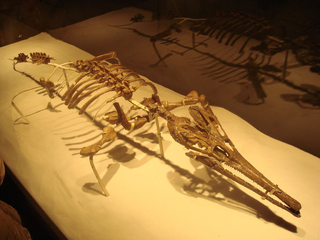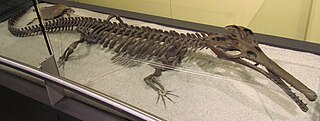The Yixian Formation is a geological formation in Jinzhou, Liaoning, People's Republic of China, that spans the late Barremian and early Aptian stages of the Early Cretaceous. It is known for its exquisitely preserved fossils, and is mainly composed of basalts interspersed with siliciclastic sediments.

Choristodera is an extinct order of semiaquatic diapsid reptiles that ranged from the Middle Jurassic, or possibly Triassic, to the Miocene. Choristoderes are morphologically diverse, with the best known members being the crocodile-like neochoristoderes such as Champsosaurus. Other choristoderans had lizard-like or long necked morphologies. Choristoderes appear to have been confined to the Northern Hemisphere, having been found in North America, Asia, and Europe, and possibly also North Africa. Choristoderes are generally thought to be derived neodiapsids that are close relatives or members of Sauria.

Simoedosaurus is an extinct reptile known from the Paleocene of North America, Europe and western Asia, and a member of the Choristodera, a group of aquatic reptiles that lived in the Northern Hemisphere from the Jurassic to the early Cenozoic.

Liaoningosaurus is an unusual genus of basal ankylosaurid dinosaur from the Liaoning Province, China that lived during the Early Cretaceous in what is now the Yixian and Jiufotang Formation. The type and only species, Liaoningosaurus paradoxus, is known from more than 20 specimens, with some representing juveniles. It was named in 2001 by Xu, Wang and You.

Shokawa is an extinct genus of choristoderan diapsid reptile, known from the Lower Cretaceous of Japan. It is only known from one species, Shokawa ikoi. The only known remains are a postcranial specimen lacking the skull, discovered at the KO2 locality in sediments belonging to the Okurodani Formation near the village of Shokawa in Gifu Prefecture. Shokawa possessed a long neck with at least 16 cervical vertebrae, and closely resembles and is closely related to the smaller choristoderan, Hyphalosaurus. The generic name refers to the village near where it was found, while the specific name honors the collector of the first specimen, one Mr. Ikoi Shibata.

The Jehol Biota includes all the living organisms – the ecosystem – of northeastern China between 133 and 120 million years ago. This is the Lower Cretaceous ecosystem which left fossils in the Yixian Formation and Jiufotang Formation. These deposits are composed of layers of tephra and sediment. It is also believed to have left fossils in the Sinuiju series of North Korea. The ecosystem in the Lower Cretaceous was dominated by wetlands and numerous lakes. Rainfall was seasonal, alternating between semiarid and mesic conditions. The climate was temperate. The Jehol ecosystem was interrupted periodically by ash eruptions from volcanoes to the west. The word "Jehol" is a historical transcription of the former Rehe Province.
The Jiufotang Formation is an Early Cretaceous geological formation in Chaoyang, Liaoning which has yielded fossils of feathered dinosaurs, primitive birds, pterosaurs, and other organisms. It is a member of the Jehol group. The exact age of the Jiufotang has been debated for years, with estimates ranging from the Late Jurassic to the Early Cretaceous. New uranium-lead dates reveal the formation is deposited in the Aptian stage of the Early Cretaceous. Fossils of Microraptor and Jeholornis are from the Jiufotang.

Lazarussuchus is an extinct genus of amphibious reptile, known from the Cenozoic of Europe. It is the youngest known member of Choristodera, an extinct order of aquatic reptiles that first appeared in the Middle Jurassic. Fossils have been found in Late Paleocene, Late Oligocene, Early Miocene and possibly Late Miocene deposits in France, Germany, and the Czech Republic. Two species have been named: the type species L. inexpectatus ("unexpected") from the late Oligocene of France. and L. dvoraki from the early Miocene of the Czech Republic. It was not a large animal; with the total preserved body and tail length of L. inexpectatus being just over 30 centimetres. A complete specimen of Lazarussuchus with preserved soft tissue was found from the Late Paleocene of France, but has not been assigned to a species.
Liaoxisaurus is a genus of choristodere, a type of crocodile-like aquatic reptile. It is known from a partial specimen found in Aptian-age Lower Cretaceous rocks of the Jiufotang Formation, Chaoyang, Liaoning, China. Liaoxisaurus was named in 2005 by Gao Chunling, Lü Junchang, and colleagues. The type species is L. chaoyangensis.

Monjurosuchus is a genus of choristoderan reptile that lived in what is now China and Japan during the Early Cretaceous. It has large eyes, a rounded skull, robust legs with short claws, and a long, thin tail. Fossils have been found that preserve soft tissue, showing that it had soft skin and webbed feet.
Longicrusavis is an extinct genus of basal ornithuromorph bird found only at Dawangzhangzi village in Liaoning Province, China. Longicrusavis was a ground dwelling carnivore, a wader, and part of biological family Hongshanornithidae, considered to have been a dominant species in the Jehol Biota, the prehistoric Chinese ecosystem which supported them. The name Hongshanornithidae represents one of China's oldest recorded cultures in the region, the Hongshan culture.

Khurendukhosaurus is a genus of choristodere, a type of amphibious reptile. It is known from Lower Cretaceous rocks of Mongolia and Russia. Two species have been named. The type species, K. orlovi, was named in 1984 by Sigogneau–Russell and Efimov for the fragmentary postcranial skeleton PIN 3386/3. This specimen was discovered in the Albian-age Lower Cretaceous Khuren Dukh Formation Formation at Hüren Dukh, central Mongolia. The lake deposits at this site also contain fossils of the choristoderes Irenosaurus and Tchoiria. Other postcranial bones of K. orlovi have been found at this site as well.

Tchoiria () is a genus of neochoristoderan reptile from the Early Cretaceous of Mongolia. The name Tchoiria comes from the city of Choir which is nearby to where the holotype was found. Tchoiria is thought to have a similar diet to another neochoristoderan reptile, Champsosaurus, due to morphology of the skull. It would hunt in freshwater environments, like the living gharials, where it would prey on many different types of fish and turtles.

Neochoristodera is a lineage of specialised crocodile-like fully aquatic choristodere reptiles. Noted for their long jaws and large size, these animals were predominant across the Northern Hemisphere, occurring in freshwater and coastal environments across the Cretaceous and early Cenozoic.

Philydrosaurus is an extinct genus of choristoderan which existed in China during the Early Cretaceous. The type species P. proseilus was named in 2005. Philydrosaurus was found from the Jiufotang Formation and is slightly younger than Monjurosuchus, which was found from the Yixian Formation.
Liushusaurus is an extinct genus of lizard described by Susan E. Evans and Yuan Wang in 2010. The genus has a single species, Liushusaurus acanthocaudata, and is known from eight fossils, several of which preserve soft tissue detail. The specimens were found in the Lower Cretaceous aged Yixian Formation of Northeast China. Liushusaurus is one of eight lizards that are known and have been named from the Yixian Formation, part of the diverse Jehol Biota ecosystem.

Chuanqilong is a monospecific genus of basal ankylosaurid dinosaur from the Liaoning Province, China that lived during the Early Cretaceous in what is now the Jiufotang Formation. The type and only species, Chuanqilong chaoyangensis, is known from a nearly complete skeleton with a skull of a juvenile individual. It was described in 2014 by Fenglu Han, Wenjie Zheng, Dongyu Hu, Xing Xu, and Paul M. Barrett. Chuanqilong shows many similarities with Liaoningosaurus and may represent a later ontogenetic stage of the taxon.

Jeholochelys is an extinct genus of sinemydid turtle that lived during the Early Cretaceous of what is now China. The holotype specimen was discovered in the Jiufotang Formation of Sihedang in Lingyuan, western Liaoning. In 2018, the Chinese palaeontologist Shuai Shao and colleagues named the new genus and species Jeholochelys lingyuanensis based on the specimen. The generic name consists of "Jehol", which refers to the Jehol biota, and "chelys", which is Greek for turtle. The specific name refers to the type locality. Seven skeletons were described in the study, five nearly complete, and two consisting of shells, and hundreds of turtle fossils have been found in the area. The described specimens are kept in the Paleontological Museum of Liaoning.
Heishanosaurus is an extinct genus of choristodere reptile from the Early Cretaceous of China. The type and currently only known species is Heishanosaurus pygmaeus. It is unusual as it is much more primitive than other known choristoderes from the Early Cretaceous of Asia, and retains many plesiomorphic characters.

Brevirostruavis is a genus of Early Cretaceous enenatiornithine bird from the Early Cretaceous Jiufotang Formation of Liaoning, China. The type and only species is Brevirostruavis macrohyoideus.

























